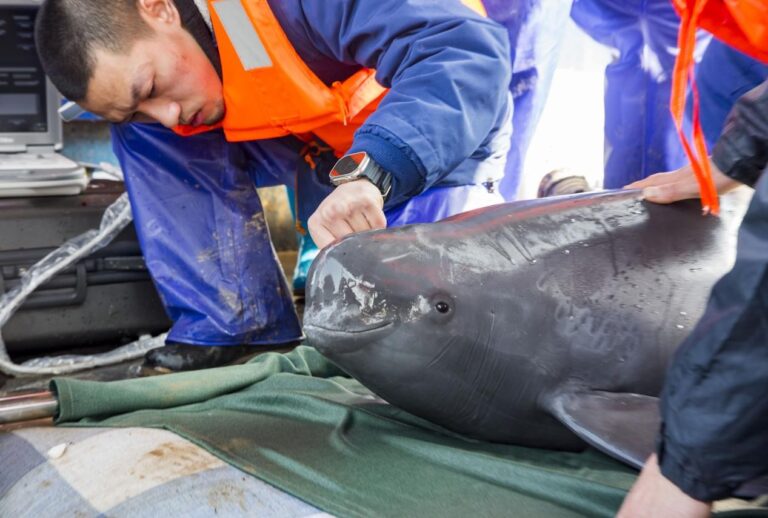
By Qiang Yuwen, In the Xiba section of the Yangtze River located in Yichang city, central China’s Hubei province, conservation photographer Yang He captured a rapid series of shots as a Yangtze finless porpoise surfaced. During the autumn of 2022, he documented a rare phenomenon at this site: multiple porpoises engaging in coordinated fish-herding behavior.
This area has since been designated as a primary monitoring site on the groundbreaking “Yangtze finless porpoise tracking map.” On weekends, families frequently visit the location, equipped with binoculars and guided by the tracking map to observe these elusive creatures.
Recognized for their rounded heads, robust frames, and uniform grayish-white skin, Yangtze finless porpoises are affectionately dubbed the river’s “smiling angels”. As an endemic species exclusive to China’s longest waterway, they hold the highest conservation status as a national first-class protected wild animal.
However, habitat loss, accidental capture, water pollution, and climate change have all contributed to a drastic population decline. In 2013, they were classified as “critically endangered.”
In recent years, provinces and municipalities along the Yangtze River have prioritized ecological restoration by implementing the principle of “enhancing conservation while halting overdevelopment.” These efforts have marked a critical turning point in environmental protection across the the Yangtze River Economic Belt. As fish populations rebound and biodiversity thrives, endangered Yangtze finless porpoise has shown signs of population recovery.
In October 2024, the “Yangtze finless porpoise tracking map” was unveiled at the Workshop on Conservation of Global Endangered Small Cetaceans, co-hosted by the Hubei Provincial Department of Science and Technology and the Institute of Hydrobiology under the Chinese Academy of Sciences.
The map was developed through a yearlong field study conducted in 2023 by the “Porpoise Tracking Project” team. A team member noted, “Water quality in the middle and lower Yangtze habitats of the finless porpoise remains consistently excellent. During our survey at the mouth of Dongting Lake in Yueyang, Hunan povince, we observed over a dozen porpoises surfacing repeatedly.”
Lv Xiangbo, head of the Wuhan R&D center of Lenovo Research, explained that the team compiled extensive data over the year, leveraging in-house AI technology to pinpoint porpoise activity patterns.
Mei Zhigang, associate researcher at the Institute of Hydrobiology, added, “Sonic detection devices have been deployed in critical habitats to support science-driven conservation strategies.”
Today, in photos captured by Yang He, oil-stained chemical docks have been transformed into scenic riverside parks, and illegal sand dredging vessels are no longer seen.
Thanks to sustained conservation efforts, sightings of finless porpoises along the Yangtze river have grown increasingly frequent. The population has rebounded historically, rising steadily to 1,249 in 2022 — a 23.42% increase from 2017. By 2024, 95.8% of water monitoring sections in Hubei province met high-quality standards, with all severely polluted sections fully remediated.










